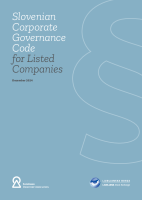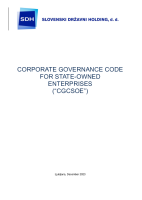CG codes:
Standards of corporate governance are defined by different reference codes with respect to the type of company. Companies that are obliged to audit have to prepare a CG statement and code compliance within the scope of its annual report they can select a reference code that is relevant to them:
Slovenian Corporate Governance Code for Listed Companies
Poglej dokumentCorporate Governance Code for Unlisted Companies
The Corporate Governance Code for Unlisted Companies (herei ...
Poglej dokumentCorporate Governance Code for State-Owned Enterprises
The Code is addressed to state-owned enterprises (SOEs). It ...
Poglej dokumentDisclosures of deviations from the Code and "comply or explain principle"
Companies that choose to complyone of the reference codes have to disclose their deviations from the code. The purpose of disclosure is to present the specifics of company’s corporate governance to investors and other stakeholders. In doing so, it is vital that the company assesses on its own which code practice will follow. Deviations from the recommendations in the reference code are to be explained in a manner presenting the reasons for having assessed a recommendation as inappropriate for the company and presenting an alternative solution that is more appropriate with respect to the company’s special features. This way, a company provides the transparency of the corporate governance model for the company and enables shareholders, investors and other stakeholders to assess the quality of governance at that company. The purpose of the statement on compliance, therefore, is not to “blindly” follow all provisions of the code, as the recommendation in the code fails to present the best solution for all companies.
Monitoring Reports of CG compiances on Slovenia:
- *Report on compliance with the CG code for listed companies in Slovenia for the 2015: Poročilo o analizi skladnosti s Kodeksom upravljanja javnih delniških družb v Sloveniji v letu 2015, 2016
- *Practical guidance for quality explanations in CG statements on compliance: Praktični napotki za kakovostna pojasnila v izjavah o upravljanju, 2016
- *Analysis of compliance with the CG code for listed companies in Slovenia 2011-2014: Analiza skladnosti s Kodeksom upravljanja javnih delniških družb v Sloveniji za obdobje 2011-2014, 2015
- *Analysis of disclosures of deviations in statements: Analiza razkritij odstopanj v izjavah o skladnosti s Kodeksom, 2012
*only in Slovene language
Governance in companies with capital assets of the state
Slovenia still has a large share of companies with capital assets of the State and their governance is regulated by different acts and guidelines of the Slovenian Sovereign Holding
Best practice recommendations:
Recommended reading:
Bank Governance
Due to the specific position and importance of banks for the national economy, they are subject to a series of other regulations and guidelines of best practices as accepted by national or European regulators or relevant CG codes' custodians.
Legislation:
- Zakon o bančništvu – ZBan-3
- Sklep o skrbnosti članov uprave in nadzornega sveta bank in hranilnic, UR.l.RS, št. 62/11 in sklep o dopolnitvah Ur.l.RS, št. 74/13
Recommended reading:
-
Guidance for the Directors of Banks (IFC)
25. 10. 2021 | Documents
Internal Group Governance
Recommended reading:
-
Duties and Responsibilities of Boards in Company Groups
03. 06. 2020 | Documents
-
Group interest and subsidiary governance in Luxembourg, ILA
15. 06. 2015 | Documents
-
Challenges in Group Governance: The Governance of Cross-Border Bank Subsidiaries, IFC, Fokus 13
26. 10. 2021 | Documents



